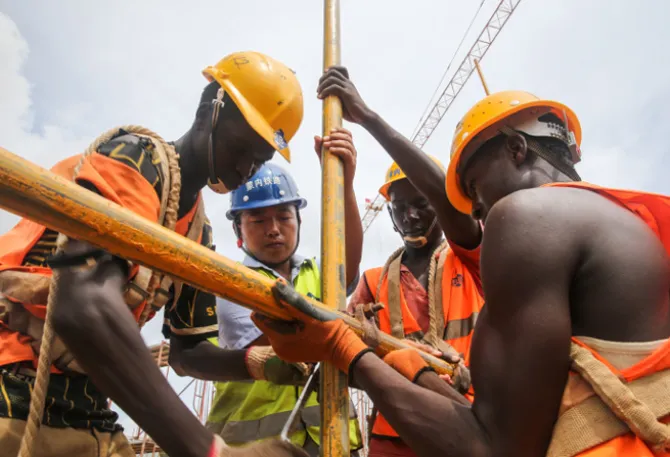
From 17 to 18 October, China hosted the third Belt and Road Forum (BRF) for International Cooperation in Beijing. This year’s forum was unique since it commemorated the 10th anniversary of the Belt and Road Initiative (BRI). The summit in Beijing saw the participation of ministers and senior officials from 130 countries and 30 international organisations. Vladimir Putin, the President of Russia, was one of the prominent guests who spoke with President Xi, as he did during the previous two summits in 2017 and 2019. However, India skipped the summit, as it had done in the past two editions.
China has signed over 200 BRI cooperation agreements with more than 150 countries and 30 international organisations.
Ten years ago, when China launched the BRI, it was intended to establish both land and sea connections between Asia and Europe via Africa. Since then, China has signed over 200 BRI cooperation agreements with more than 150 countries and 30 international organisations. During this time, China’s commerce with BRI members reached US$19.1 trillion, growing at an average annual rate of 6.4 percent. The two-way investment between China and its partners has also reached US$380 billion. When it comes to Africa, since the launch of BRI, China’s influence in the continent has been steadily growing. At present, 53 out of 54 nations in Africa are part of the BRI. However, after reaching its peak in 2016, Chinese loan volume in Africa steadily decreased. During 2020–2022, the COVID-19 pandemic’s economic impacts hastened this decline as loan averages fell by 37 percent from US$213.03 million to US$135.15 million between the pre-pandemic years (2017–2019) and the pandemic years (2020–2022). Indeed, there are multiple explanations for this steady decline. The global financial order that got strained by the COVID-19 outbreak, and then later by the ongoing turmoil in Ukraine, has resulted in the shrinking of Chinese public funding. Furthermore, China experienced domestic challenges during this period. Local government revenue has always played a key role in China’s growth. Yet, during the pandemic in 2021, falling property and land values and increased government spending caused revenue shortages for local governments. In the first eight months of 2022, provinces had a revenue deficit of US$948 billion. Rising youth unemployment, an ageing population, and geopolitical unrest all impacted the Chinese decision to reduce their large-scale debts.
China experienced domestic challenges during this period. Local government revenue has always played a key role in China’s growth.
In light of this, a factual review of China’s recent economic interactions with Africa would help to analyse the current trend and forecast some outcomes for Africa from the recent BRF and beyond.
Lender and sectoral composition
In 2022, Africa had nine loans from China totalling US$994.48 million, down from US$1.22 billion in 2021, making it the second year in a row when Africa received less than $2 billion from China. The Export-Import Bank of China (CHEXIM) and the China Development Bank (CDB) together made up 79 percent of all loans in terms of the total amount. The China Shipbuilding Trading Company (CSTC), China National Aero-Technology Import and Export Corporation (CATIC), and the Bank of China (BoC) were among the other lenders.
The Export-Import Bank of China (CHEXIM) and the China Development Bank (CDB) together made up 79 percent of all loans in terms of the total amount.
Transport, environment, ICT, education, defence and military, water/sanitation/waste, industry, trade, and services were among the traditional and non-traditional sectors that received funding in 2021–2022. Nonetheless, 72 percent of all loan commitments were directed towards the transport, energy, and ICT industries, highlighting the importance of infrastructure development for China.
Geographical composition
Sixty-nine percent of the financing from 2000 to 2022 went to Angola, Ethiopia, Kenya, Zambia, Egypt, Nigeria, Sudan, South Africa, Cameroon, and Ghana, indicating the distribution of major borrowers across the continent. Additionally, borrowers’ geographic makeup was different from prior years. In 2021 and 2022, West African nations that had not been big borrowers in the previous 20 years got sizable loans.
When the BRI was unveiled, only East Africa and the Horn of Africa were part of BRI to create a maritime trade route connecting the Indian Ocean and the Suez Canal.
Considering the prominence of Southern and East Africa in the Chinese scheme of things, West Africa’s borrowing in 2021–2022 is noteworthy. One possible reason is that the West African countries officially joined the BRI scheme much later. In 2013, when the BRI was unveiled, only East Africa and the Horn of Africa were part of BRI to create a maritime trade route connecting the Indian Ocean and the Suez Canal. While this did not exclude other African countries from borrowing Chinese loans, multiple BRI projects were developed across East Africa, such as the Ethiopia-Djibouti Standard Gauge Railway (SGR) in 2013 and the Kenyan SGR in 2014. Therefore, loan commitments to East Africa peaked in 2013. However, as China is aiming for ports on the Western coasts of Africa, since 2018, Chinese loans to West Africa increased drastically, primarily due to the loans to Ghana and Nigeria.
Debt relief
As a consequence of the COVID-19 pandemic, roughly 40 percent of African countries were at high risk of debt distress, and about 18 percent were in debt distress in 2021. In 2021, 30 of the 48 countries that were part of the G20 Debt Service Suspension Initiative (DSSI) were from Africa. Leading African debtors, including Ethiopia and Zambia, applied for G20 Common Framework debt relief in 2021; Ghana followed suit in 2022. During the DSSI period, Angola was granted a debt moratorium of US$6.2 billion. China had to forgive 23 loans for 17 African countries and provide debt refinancing and deferrals to several other African nations.
Leading African debtors, including Ethiopia and Zambia, applied for G20 Common Framework debt relief in 2021.
Unsuccessful negotiations and abandoned projects
Some key reasons for unsuccessful negotiations and abandoned projects include disagreements over terms, the risk that African countries won’t pay their share of project costs, concerns about African debt levels, and China’s promise to stop funding coal projects abroad gradually. For example, due to stalled negotiations, Botswana withdrew from a 300-km road rehabilitation project. This was because the financial negotiation took longer than expected because of discrepancies in terms and conditions. Kenya and Uganda pulled out of negotiations for the Naivasha to Kampala standard gauge railway (SGR) in 2023 for the same reason. Earlier, the Industrial and Commercial Bank of China Ltd (ICBC) ceased funding the US$3 billion worth of Sengwa coal-fired power plant in Zimbabwe and the Lamu coal-fired power station in Kenya.
Conclusion
The BRI was conceptualised under the Chinese ethos as seen in the Chinese proverb, “If you want to get rich, build roads first”. However, the world is currently going through a period of strong turbulence and rapid transformation. As a result, Chinese BRI projects in Africa are also evolving in response to this fast-changing world. At the 2021 Belt and Road Construction Symposium, Chinese President Xi Jinping emphasised the need for creative approaches to international lending through the Green BRI and “xiao er mei strategies”.
The recent Belt and Road Forum and the upcoming FOCAC sessions in 2024 will shed more light on whether these observed lending arrangement changes will continue to prevail in the future of China’s BRI projects in Africa.
The phrase “xiao er mei” literally translates as “small and beautiful,” indicating that lenders should try to support both modest and valuable endeavours. Here, loans under US$50 million or large syndicated loans, where multiple lenders each contribute a sizeable share of the loan, are considered “small”. And projects that possess significant financial viability, favourable social and environmental outcomes, and/or political significance are considered “beautiful”. Further, late last month, Beijing released a white paper titled “A Global Community of Shared Future: China’s Proposals and Actions”. This document provides insight into potential topics of the summit. Chinese loan financing trends in Africa will likely rebound, but surely not to the peak years’ heights. The recent Belt and Road Forum and the upcoming FOCAC sessions in 2024 will shed more light on whether these observed lending arrangement changes will continue to prevail in the future of China’s BRI projects in Africa. However, as it stands now, smaller value loans under US$50 million and loans with more favourable social and environmental outcomes will likely dominate future BRI projects in Africa.
Samir Bhattacharya is a Senior Research Associate at Vivekananda International Foundation.
The views expressed above belong to the author(s). ORF research and analyses now available on Telegram! Click here to access our curated content — blogs, longforms and interviews.




 PREV
PREV


